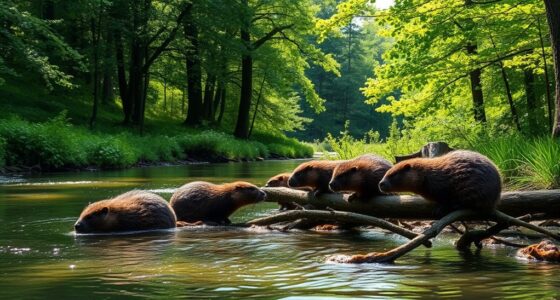Silent logging quietly destroys rainforests by fragmenting habitats and disrupting wildlife through small-scale, hidden practices. This causes species to lose crucial migration routes, reduces genetic diversity, and makes ecosystems more vulnerable to invasive species and climate change. Indigenous communities face encroachment and loss of their traditional ways. These unseen impacts threaten the rainforest’s ecological stability and biodiversity. To understand how these subtle actions have massive consequences, keep exploring what’s at stake if they continue.
Key Takeaways
- Silent logging gradually fragments rainforests, disrupting ecosystems and threatening biodiversity without large visible scars.
- It isolates animal populations, impairs migration routes, and reduces genetic diversity, increasing extinction risks.
- Indigenous communities face land encroachment, loss of cultural practices, and marginalization from logging activities.
- Small-scale logging weakens ecological resilience, making forests more vulnerable to invasive species and climate change.
- Raising awareness about these hidden impacts is crucial to protect rainforest ecosystems and preserve global environmental health.

Rainforests, often called the lungs of the Earth, are facing unprecedented threats that jeopardize their survival. As you walk through these lush environments, you might not immediately notice the subtle signs of damage caused by what’s often called “silent” logging. Unlike large-scale clear-cutting, silent logging quietly chips away at these essential ecosystems, leaving behind scars that are less visible but equally destructive. One of the most significant impacts is habitat fragmentation, which occurs when continuous forest areas are broken into smaller, isolated patches. This fragmentation disrupts the delicate balance of life, making it harder for species to find food, reproduce, and migrate. As a result, many animals and plants struggle to survive, and some edge closer to extinction.
Silent logging fragments rainforests, threatening biodiversity and indigenous communities alike.
You need to understand that this process doesn’t just harm wildlife; it also directly affects indigenous communities who live within these forests. Indigenous rights are often overlooked in the rush to exploit rainforest resources. These communities have depended on the forest’s resources for generations, relying on it for food, medicine, and cultural practices. When silent logging occurs, it encroaches upon their land, stripping away their rights and disrupting their way of life. You might see this as just environmental damage, but it’s also a human rights issue, as indigenous peoples are pushed out or marginalized in the process. Their traditional knowledge and stewardship are crucial for maintaining the health of these ecosystems, yet their voices are frequently ignored in decisions about logging activities.
Furthermore, habitat fragmentation caused by silent logging accelerates biodiversity loss. Smaller forest patches become more vulnerable to invasive species, disease, and climate change. Fragmented habitats also hinder animal movement, preventing species from migrating to more suitable areas. This isolation can lead to inbreeding and a decline in genetic diversity, weakening populations and making them more susceptible to extinction. You might think that small patches of forest are insignificant, but collectively, they can cause a cascade of ecological failures that threaten the entire rainforest. This process often happens quietly, without the loud protests of large-scale deforestation, but its impacts are just as severe. Additionally, the disruption of ecological corridors hampers natural species migration, further endangering the resilience of these ecosystems.
In the end, you can’t ignore that silent logging is quietly unraveling the intricate web of life in rainforests. It undermines the rights of indigenous peoples, accelerates habitat fragmentation, and diminishes biodiversity. Protecting these forests requires awareness and action, emphasizing that every small effort counts in preserving the planet’s green lungs for future generations.
Frequently Asked Questions
How Does “Silent” Logging Differ From Traditional Logging Methods?
Silent logging differs from traditional methods because it often involves covert, unregulated practices that can bypass sustainable practices and legal enforcement. You might not notice it, but it causes significant harm by selectively removing valuable trees without proper oversight. Unlike transparent logging, silent logging evades laws designed to protect forests, making it harder to manage and combat. This clandestine approach threatens ecosystems and sustainable forest management efforts.
What Are the Long-Term Ecological Effects of Undetected Logging?
Imagine a vibrant rainforest slowly losing its color; without detection, logging causes silent destruction. You might not see the immediate impact, but long-term, biodiversity loss accelerates, and soil degradation worsens. Over time, ecosystems weaken, risking collapse. This unseen logging strips away essential habitats, disrupting delicate balances. You must understand that these silent cuts threaten the rainforest’s resilience, making recovery impossible without early detection and intervention.
Can “Silent” Logging Be Completely Prevented or Stopped?
You can’t completely prevent or stop “silent” logging because legal loopholes often allow it to persist. Strengthening policy enforcement is essential, but loopholes need closing to make a real difference. You can advocate for stricter regulations and better monitoring to reduce illegal activities. While total elimination’s tough, persistent effort and smarter laws can considerably curb “silent” logging’s impact, helping protect critical ecosystems.
How Do Local Communities Perceive “Silent” Logging Practices?
You might think local communities see “silent” logging as harmless, but they often view it as a threat to indigenous rights and cultural preservation. Ironically, what seems quiet and unnoticed can cause loud disruptions in their lives. They perceive “silent” logging as a stealthy attack on their heritage, risking loss of traditions and lands. Their perspectives highlight the importance of respecting indigenous rights and protecting the cultural fabric tied to their environment.
What Technologies Are Used to Detect Covert Logging Activities?
You can use remote sensing technologies like satellite imagery to detect covert logging activities from afar, monitoring changes in forest cover over time. Drone surveillance also plays a vital role by providing real-time, high-resolution images of remote or inaccessible areas. These tools help authorities identify illegal logging swiftly, enabling quicker responses and better forest management, ultimately protecting the rainforest from silent, hidden threats.
Conclusion
Imagine your favorite garden quietly wilting, unseen pests nibbling away at its roots. That’s what “silent” logging does to the rainforest—hidden damage beneath the canopy, threatening its vibrant life. If you ignore these quiet threats, the lush forest becomes a forgotten shadow of itself. But if you act now, like tending to that garden, you can help restore its health. The rainforest’s future depends on your awareness and care—don’t let it fade into silence.









